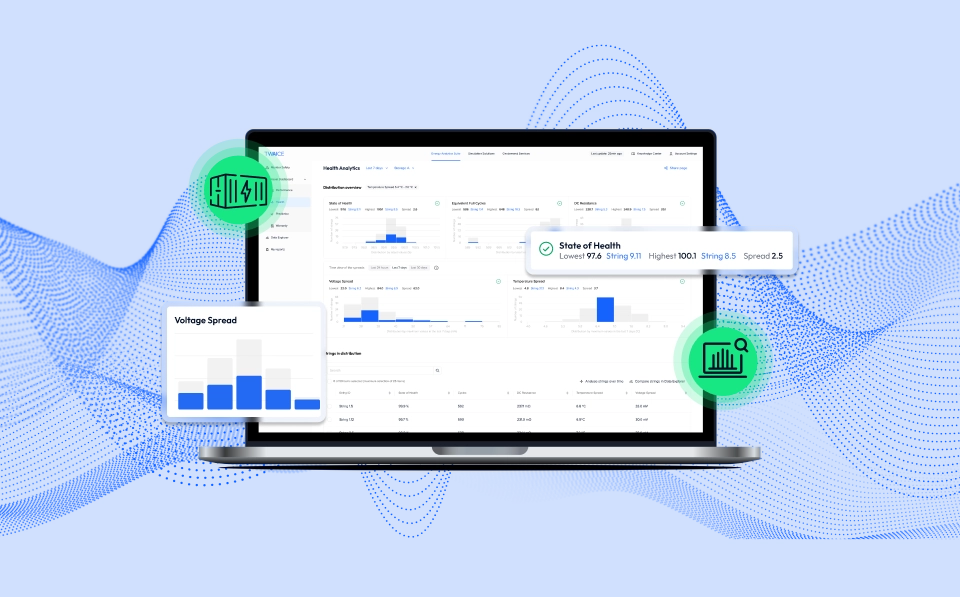Learn how to optimize your energy storage with accurate state of charge estimation
%2520(1).jpeg)
Learn how to optimize your energy storage with accurate state of charge estimation
%2520(1).jpeg)
Proper state estimation of batteries is of the utmost importance in all cases where batteries are used. You can only operate your battery energy storage system (BESS) to its full potential while keeping it safe if you know accurately in which condition your storage system is in. State of Charge (SoC) is one of the most important state estimations for batteries. It describes how much charge is left in your battery, which can be used, for example, to provide grid services like frequency regulation or arbitrage.
An inaccurate SoC can cause safety issues and economic losses due to non-reliable storage operation. Not being able to deliver the energy that had been promised to the grid can lead to high fines or even permanent exclusion from grid service markets. Major challenges exist when it comes to calculating State of Charge, often leading to inaccurate SoC readings.
In this article, we explain the importance of State of Charge estimation for energy storage systems, why the SoC provided by the BMS is not enough, and how battery analytics can provide a more accurate State of Charge to storage system integrators, owners and operators.
There are many different ways to calculate State of Charge. However, many storage owners and operators rely on the battery management system. In this article, we want to focus on the way the BMS calculates State of Charge, and why energy storage system owners should not rely on this.
Battery Management Systems measure the three parameters current, voltage and temperature within a battery, therefore uses these measurements to calculate the State of Charge. However, this has several limitations, meaning the BMS is unable to provide an accurate SoC. There are many reasons for this:
The State of Charge is the most important metric for energy trading. It shows traders how much capacity the system has, therefore shows how much energy can be traded. There are two implications if the State of Charge is incorrect. Firstly, traders leave money on the table. They give much lower bids because they don’t know that the BESS is able to provide more energy. Secondly, they might bid too much energy and be unable to fulfil their bid, leading to penalties.
An inaccurate State of Charge has significant risks for system safety. An inaccurately high SoC could prevent the system from recognizing a fully charged state, leading to overcharging. This can cause overheating, increased pressure and in severe cases, thermal runaway. An inaccurately low SoC might lead to deeper discharges than the battery is designed to handle, which leads to degraded life and performance due to increased strain on the cells. If doing a frequency response use case (i.e. FCR in Europe or Dynamic Containment in the UK) at high or low SoC regions, the power output of the battery is limited, which can otherwise lead to overheating. As FCR requires a large power bandwidth due to its unpredictable nature, it’s even more important to accurately know the battery’s SoC due to the risk of overheating.
The challenges involved in calculating an accurate State of Charge mean that advanced algorithms and in-depth analysis provide the only hope of using a SoC that can truly be relied upon to make important trading decisions, providing energy to the grid, and ensuring the safety of the BESS.
Battery analytics software leverages a combination of advanced data analysis, battery expertise, machine learning, as well as multiple SoC modeling approaches. It interprets vast amounts of data from the BMS, meaning it can reveal patterns and correlations that cannot be made by simple SoC estimation methods. Millions and billions of data points are ingested from the field meaning changes in degradation, temperature, current and many more factors can be accounted for. Battery analytics additionally has the computing power necessary.
Interested in a real-life example about how an inaccurate SoC from the BMS lead to system shutdown for an energy storage integrator and owner? The pdf-version of this article includes it.

Sign up for the next live group demo and learn how TWAICE can transform your BESS operations. In just 30 minutes, you’ll get a demo of key features and use cases, and engage with our product experts for a live Q&A.

